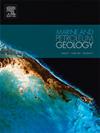Sabkha deposition on an epicontinental-foredeep: The petroleum-bearing Cane Creek interval of the Pennsylvanian Paradox Formation, in the Paradox Basin, Utah, U.S.A.
IF 3.7
2区 地球科学
Q1 GEOSCIENCES, MULTIDISCIPLINARY
引用次数: 0
Abstract
The Pennsylvanian Paradox Formation in the northern fold and fault belt of the foreland Paradox Basin, southeastern Utah, contains 4th and 5th order cyclothems of closed basin halite salt packages (60–92 m thick) interbedded with intervals of evaporitic-carbonate-siliciclastic (n = ∼30 cycles, each <36 m thick). The cyclothems record rhythmic high-stand and low-stand deposition in an epicontinental foredeep marine basin influenced by subsidence, arid subtropical climate, and sea level changes that created continental inlets on the edge of the Panthalassic Ocean. Here, we document evaporitic-carbonate-siliciclastic facies of the unconventional hydrocarbon Cane Creek interval, clastic cycle 21, from eight cored drillholes spanning a northwest to southeast transect that represent sabkha-type deposition of an ancient interior seaway. This interpretation is collective from several past studies, however, a comparative sedimentological approach for the origin of depositional textures provides a finer scale description of parasequences that internally contain meter-scale shallowing upward successions. The successions are both allocyclic and autocyclic related to marine transgressions and regressions within a restricted, tidally influenced, marine basin and associated with subtidal, intertidal, and supratidal paleoenvironments. The Cane Creek is informally divided into three distinct stratigraphic zones: from top to bottom A, B, and C zones. The A and C zones are composed of fabric-destructive and laminated anhydrite laths, dolomitic mudstone, and algal-laminated source rock mudstones (15–20 wt % total organic carbon), interpreted as prograded supratidal flats during marine regressions. Anhydrite textures vary from finely laminated needles with dolomitic mud drape couplets, upward directed syntaxial crystalline fabric draped by silty dolomitic mud, and nodular laths. Volumetrically, smaller proportions of anhydrite occur in the C zone in the northwest part of the basin attributed to tidal inlet dilution. Intraclastic mudstone lag deposits composed of compacted mudrock clasts overlay anhydrite beds and are interpreted as diachronous storm or subaqueous debris flow deposits. The middle B zone is primarily low-permeable muddy sandstone to siltstone (0.009–0.202 mD; porosity 6%–17%) that contains bidirectional lenticular ripples, slack water mud drapes, trace fossil burrows, diagenetic anhydrite-dolomite-quartz-halite cements, and interbeds of organic-rich mudstone, and stratigraphically thickens to the northwest. Siliciclastic supply is interpreted as being sourced by fluvial drainage from the Uncompahgre Ancestral Rocky Mountains uplift and eolian processes that later were reworked by tidal and storm processes. Source rock analysis of interbedded organic-rich mudstones within all zones are mixed type I and II (lacustrine and marine) with more fluvial detrital type III in the southern part of the basin. Thin interbedded organic-rich mudstones (cm scale) within the B zone host open marine conodont elements of Idiognathodus obliquus and Idiognathodus amplicus that drifted through the interior seaway to their demise during Desmoinesian time. Vitrinite reflectance data also indicate deeper burial, positioned within the dry/wet gas window (VRo ∼1.8) as compared to the central (oil productive) and southern play areas that have lower maturity (VRo 1.1 and 1.5, respectively).
求助全文
约1分钟内获得全文
求助全文
来源期刊

Marine and Petroleum Geology
地学-地球科学综合
CiteScore
8.80
自引率
14.30%
发文量
475
审稿时长
63 days
期刊介绍:
Marine and Petroleum Geology is the pre-eminent international forum for the exchange of multidisciplinary concepts, interpretations and techniques for all concerned with marine and petroleum geology in industry, government and academia. Rapid bimonthly publication allows early communications of papers or short communications to the geoscience community.
Marine and Petroleum Geology is essential reading for geologists, geophysicists and explorationists in industry, government and academia working in the following areas: marine geology; basin analysis and evaluation; organic geochemistry; reserve/resource estimation; seismic stratigraphy; thermal models of basic evolution; sedimentary geology; continental margins; geophysical interpretation; structural geology/tectonics; formation evaluation techniques; well logging.
 求助内容:
求助内容: 应助结果提醒方式:
应助结果提醒方式:


